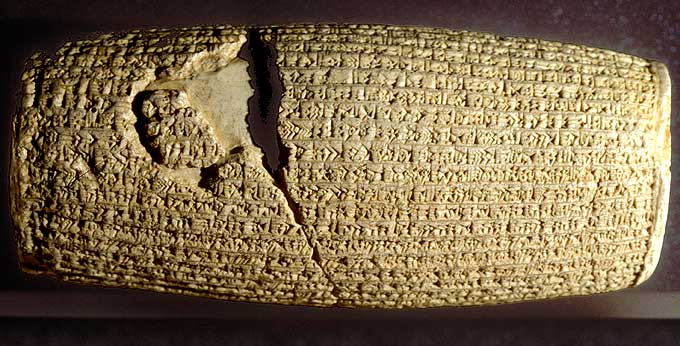The King of Persia Defeats Babylon
“the gods, who resided in them, I brought back to their places, and caused them to dwell in a residence for all time.”
Date- c. 535 BCE
Current Location- British Museum, London, England (BM 90920 + BIN II, no. 32)
Language and Script- Assyrian?; cuneiform
Biblical Verses- Isaiah 45-1; Ezra 1-1–6; 6-1–5; 2 Chronicles 36-22–23
General Information-
In 539 BCE, Cyrus II, founder of the Achaemenid dynasty in Persia, conquered the city of Babylon, bringing the Neo-Babylonian Empire to a close and inaugurating the period of Persian domination of the Near East. After taking control of Babylon, Cyrus renovated the city’s fortifications and commemorated his deeds on this clay barrel. He writes in Akkadian, which was still the language of royal documents, that his victory was achieved with the support of Marduk, the god of Babylon. His rationale is that Nabonidus, the Babylonian king whom he deposed, neglected the gods of Babylon and oppressed its people. Heeding the complaint of the people, Marduk departed from the tainted city “and scoured all the lands, looking for a righteous ruler” to reinstate his worship in Babylon. He chose Cyrus for his “good deeds and just heart” and his fair treatment of the people of Mesopotamia in the past. With this line of reasoning, Cyrus claims that he “entered Babylon as a friend” and was welcomed by the people as a liberator rather than as a conqueror.
Relevance to Ancient Israel-
Biblical scholars have pointed out that Cyrus’s attribution of his victory to the aid of Marduk is similar to statements made in Isaiah 40–55, a section of the Bible that was composed at about the same time as the Cyrus Cylinder. Isaiah also announces (Isaiah 46–47) the fall of Babylon, but in his view it is Yahweh, the god of Israel, who has chosen Cyrus and given him victory. In an oracle (Isaiah 41-25), Yahweh proclaims, “I stirred up one from the north … from the rising of the sun…, [and] he tramples rulers like mortar, as the potter treads clay.” Later (Isaiah 45-1) Yahweh speaks explicitly “concerning Cyrus, his anointed one- ‘I have grasped his right hand to subdue nations before him.’”
The Cyrus Cylinder is also important for biblical studies because it sets the background for what seems to be the incredible story of Cyrus’s allowing the return of the Judean exiles and the rebuilding of the Temple in Jerusalem. Cyrus’s claims of stewardship from Marduk and his acceptance and reinstitution of the local religion of Babylon, rather than imposing Persian religious norms, shows his policy of support for local religions, one that was not often followed by conquering empires. This corroborates copies of official documents that are preserved in the Book of Ezra regarding the Judeans. One (Ezra 1-2–4; compare with 2 Chronicles 36-23) is a proclamation in Hebrew which asserts that Yahweh instructed Cyrus to build a Temple in Jerusalem and by his decree Jews may return to Israel to assist in its construction. Another decree (Ezra 6-1–5) , in Aramaic, provides for the rebuilding of the Jerusalem Temple at the expense of the imperial treasury.
Circumstances of Discovery and Acquisition-
The Cyrus Cylinder was discovered in 1879 by Hormuzd Rassam during excavations in Babylon sponsored by the British Museum. In 1970, the German Assyriologist P. R. Berger determined that a small fragment in Yale’s Nies Babylonian Collection actually belonged to this cylinder and it was sent to the British Museum to be joined to the main body of the clay barrel. The additional text on this fragment describes Cyrus’s renovation activities in Babylon, shedding light on the circumstances surrounding the cylinder’s composition.
